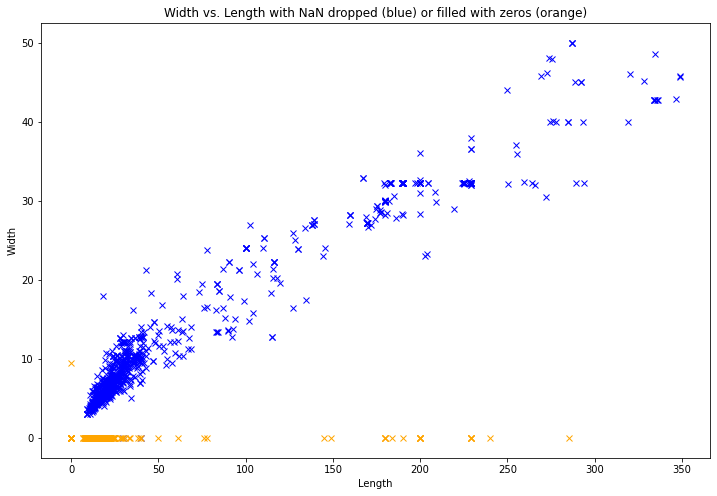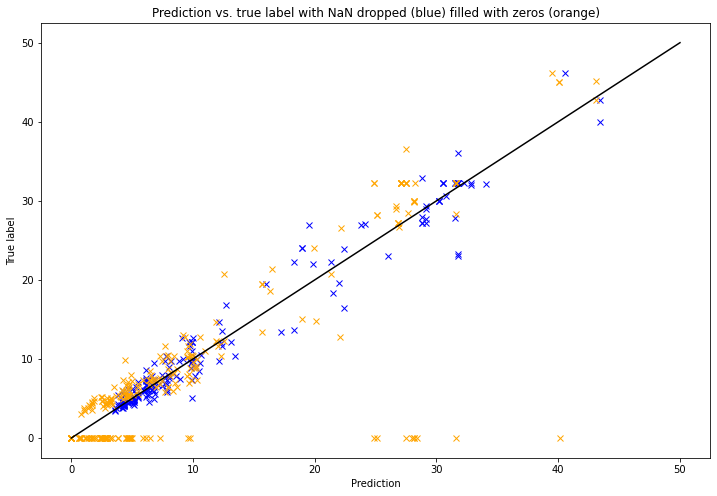Information
Section: Predict the width of a ship
Goal: Understand how dealing with missing values impact the model, the predictions and the performance.
Time needed: 20 min
Prerequisites: AIS data, basics about machine learning
Predict the width of a ship¶
Your customer would like a model that is able to predict the width of a ship, knowing its length. For this first task, the model will take only the length attribute as an input, and predict the width. You can use the static dataset.
Let’s import it first.
%run 1-functions.ipynb # this line runs the other functions we will use later on the page
import pandas as pd
static_data = pd.read_csv('./static_data.csv')
Detect the missing data¶
There are simple ways to detect missing values with Pandas. First, we can see it with the methods we saw earlier:
info() allows us to see the basic info of the dataset.
static_data.info()
<class 'pandas.core.frame.DataFrame'>
RangeIndex: 1520 entries, 0 to 1519
Data columns (total 22 columns):
# Column Non-Null Count Dtype
--- ------ -------------- -----
0 TripID 1520 non-null int64
1 MMSI 1520 non-null int64
2 MeanSOG 1520 non-null float64
3 VesselName 1442 non-null object
4 IMO 538 non-null object
5 CallSign 1137 non-null object
6 VesselType 1287 non-null float64
7 Length 1220 non-null float64
8 Width 911 non-null float64
9 Draft 496 non-null float64
10 Cargo 378 non-null float64
11 DepTime 1520 non-null object
12 ArrTime 1520 non-null object
13 DepLat 1520 non-null float64
14 DepLon 1520 non-null float64
15 ArrLat 1520 non-null float64
16 ArrLon 1520 non-null float64
17 DepCountry 1520 non-null object
18 DepCity 1520 non-null object
19 ArrCountry 1520 non-null object
20 ArrCity 1520 non-null object
21 Duration 1520 non-null object
dtypes: float64(10), int64(2), object(10)
memory usage: 261.4+ KB
We can see that the attributes VesselName, IMO, CallSign, VesselType, Length, Width, Draft, Cargo contain less than 1520 values, meaning some of these values are missing.
There is an automatic way to detect the missing values in the dataset. For example, we can easily get the total number of missing values for the attribute Length:
We can print the missing values with the use of the function isna().
static_data['Length'].isna().sum()
300
There are 300 missing values for the attribute Length, on a total of 1520 entries for the dataset.
Do the predictions¶
We can put both attribute names in two variables: x (containing a list of the predictive variables, here only length) and y (containing a list of the predicted variable). In general, and in the scope of this course, the list y will always contain only one variable, as we only want to predict one attribute at a time.
# Prediction of Width from Length
x = ['Length']
y = ['Width']
As the prediction of the width of a ship is a regression problem, we make the prediction with a regression algorithm (in this case, the KNN algorithm). Then we can calculate the MAE to gauge the performance of the model.
For the regression model, we use the function knn_regression() to make the prediction. We calculate the MAE with the method mean_absolute_error() from the sklearn library.
from sklearn.metrics import mean_absolute_error
pred1, ytest1 = knn_regression(static_data, x, y)
print('MAE with all data: ' + str(mean_absolute_error(pred1, ytest1)))
MAE with all data: 2.73451052631579
In the previous part, we already identified that the length and width attributes contain some missing values. We can try to make a prediction on a selected part of the dataset, that doesn’t contain missing values. For that, we drop the missing values from the dataset. We simply remove the rows that contain missing values for the attributes we use for prediction.
Then, we make a new prediction on the selected dataset and print the MAE.
To drop the rows containing missing values, we use the method dropna() on the dataframe.
static_selected = static_data[[x[0], y[0]]].dropna()
pred2, ytest2 = knn_regression(static_selected, x, y)
print('MAE without NaN: ' + str(mean_absolute_error(pred2, ytest2)))
MAE without NaN: 1.3051934065934065
The error dropped (this means that the performance of the model increased when we removed the missing data). Before coming to any conclusion, we need to analyze in details the reason of this increase of performance.
Analyze the results¶
Originally, the KNN algorithm cannot handle missing values. This means that, in the function we ran before, an additional step has been taken to ensure that the prediction was not made on a dataset containing missing values. The basic action that we chose here is to replace every missing value with 0.
Let’s have a look at the number of missing values for each attribute, to get an idea on how much of the dataset was replaced by 0 value:
print('Number of instances in the dataset: ' + str(len(static_data)))
print('Number of missing values for Length: ' + str(static_data['Length'].isnull().sum()))
print('Number of missing values for Width: ' + str(static_data['Width'].isnull().sum()))
Number of instances in the dataset: 1520
Number of missing values for Length: 300
Number of missing values for Width: 609
As we can see, for the predicted attribute Width, more than a third of the dataset was containing missing values, that were replaced by zero value.
To go further, we can compare the distribution of the dataset with missing values, and the one with replaced 0 values.
We plot the two considered attributes together. This allows us to understand how the KNN algorithm makes predictions according to the value of the Length attribute.
To replace all missing values in the dataset, we use the function fillna(), with the parameter value = 0. This parameter can be changed to any value, for example, we could decide to fill the missing values with the mean value of the rest of the Series.
Also, see this page for more information about plotting with Python.
import matplotlib.pyplot as plt
plt.figure(figsize = (12, 8))
# missing values dropped (blue)
static_selected = static_data[[x[0], y[0]]].dropna()
plt.plot(static_selected['Length'], static_selected['Width'], 'x', color = 'blue')
# missing values filled with zeros (orange)
static_zeros = static_data.fillna(value = 0)
static_zeros = static_zeros.loc[static_zeros['Length'] == 0].append(static_zeros.loc[static_zeros['Width'] == 0])
plt.plot(static_zeros['Length'], static_zeros['Width'], 'x', color = 'orange')
plt.xlabel('Length')
plt.ylabel('Width')
plt.title('Width vs. Length with NaN dropped (blue) or filled with zeros (orange)')
Text(0.5, 1.0, 'Width vs. Length with NaN dropped (blue) or filled with zeros (orange)')

# For beginner version: cell to hide
import matplotlib.pyplot as plt
import numpy as np
import ipywidgets as widgets
from ipywidgets import interact
modes = ['filled_zeros', 'drop_na']
def plot_2att(mode):
if mode == 'filled_zeros':
df = static_data.fillna(value = 0)
title = 'Width vs. Length with NaN filled with zero values'
elif mode == 'drop_na':
df = static_data[[x[0], y[0]]].dropna()
title = 'Width vs. Length with NaN dropped'
plt.figure(figsize = (12, 8))
plt.plot(df['Length'], df['Width'], 'x')
plt.xlabel('Length')
plt.ylabel('Width')
plt.title(title)
interact(plot_2att,
mode = widgets.Dropdown(options = modes,
value = modes[0],
description = 'Mode:',
disabled = False,))
<function __main__.plot_2att(mode)>
We can see that the attribute Width contains more zero values than the attribute Length: for the prediction, as the KNN algorithm bases its results on the value of the attribute Length, the model will give predictions on the diagonal more than 0 values. This will lead to a greater error, as we will see now.
Now we can have a look at the predictions made by the KNN algorithms, for both cases: we plot the predictions versus the true values (we got these lists when we used the function knn_regression()): the more the plot shows a diagonal, the better the prediction was. The line of perfect prediction has been plotted as a black diagonal (to understand more about this prediction graph, see this page).
plt.figure(figsize = (12, 8))
# Missing values dropped
pred = []
for element in pred2:
pred.append(element[0])
plt.plot(pred, ytest2, 'x', color = 'blue')
# Missing values filled with zeros
pred = []
for element in pred1:
pred.append(element[0])
plt.plot(pred, ytest1, 'x', color = 'orange')
x = np.linspace(0, 50, 50)
plt.plot(x, x, color = 'black')
plt.xlabel('Prediction')
plt.ylabel('True label')
plt.title('Prediction vs. true label with NaN dropped (blue) filled with zeros (orange)')
Text(0.5, 1.0, 'Prediction vs. true label with NaN dropped (blue) filled with zeros (orange)')

# For beginner version: cell to hide
import matplotlib.pyplot as plt
import numpy as np
import ipywidgets as widgets
from ipywidgets import interact
modes = ['filled_zeros', 'drop_na']
x = ['Length']
y = ['Width']
pred1, ytest1 = knn_regression(static_data, x, y)
pred2, ytest2 = knn_regression(static_selected, x, y)
def plot_2att(mode):
plt.figure(figsize = (12, 8))
if mode == 'filled_zeros':
pred = []
for element in pred1:
pred.append(element[0])
plt.plot(pred, ytest1, 'x')
title = 'Prediction vs. true label with NaN filled with zero values'
elif mode == 'drop_na':
pred = []
for element in pred2:
pred.append(element[0])
plt.plot(pred, ytest2, 'x')
title = 'Prediction vs. true label with NaN dropped'
x = np.linspace(0, 50, 50)
plt.plot(x, x, color = 'black')
plt.xlabel('Prediction')
plt.ylabel('True label')
plt.title(title)
interact(plot_2att,
mode = widgets.Dropdown(options = modes,
value = modes[0],
description = 'Mode:',
disabled = False,))
<function __main__.plot_2att(mode)>
From these visualizations, it is clear that in the case where the missing values were filled with zeros, the model didn’t give much zero predictions. It is then understandable that the error was greater in the case were the missing values were replaced with zeros: the prediction gave “normal” values, following the diagonal of the distribution of the attributes length vs. width, instead of giving zero values, which are considered as the true values.
As a reminder, the mean absolute error is the average of the difference between the prediction and the actual value. If the actual value is 0, the error is the value of the prediction, which tends to increase the error easily.
What is the best scenario?¶
To make a choice on how to deal with missing values in that case, we have to connect our analyzis to the meaning of the problem: if we choose to replace the missing values with zero values, this implies that we have zero values in our test set. The test set is the dataset that is compared with the data we would have in the real world, and we would make predictions on.
A zero value for the length or width of a ship is not a natural value: you will never find a ship with a length of 0 meters. So in that case, replacing missing values with zero does not make much sense and we can think that dropping the missing values is the best solution for creating a model that comes closest to a real-world situation.
Quiz¶
from IPython.display import IFrame
IFrame("https://h5p.org/h5p/embed/755089", "694", "600")

